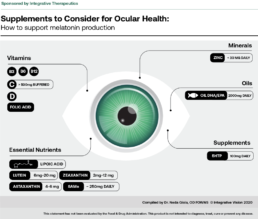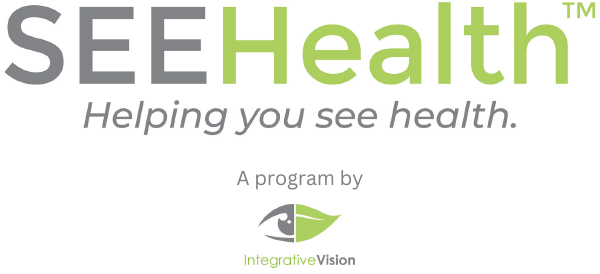Sponsored by Integrative Therapeutics
Our Modern Age of Electronics and Our Eyes
With the shift in lifestyles and increased exposure to digital elements of life, we are bombarded with information and confusion regarding the effects of light and constant exposure to Light Emitting Diodes (LED) from digital devices.
More than ever — and at younger ages — our electronic media usage is at an all-time high with more than 50% of our day increasingly spent on digital devices. The physiological connection of light and actual metabolic, as well as endocrine functions is obvious and should be top of mind as we continue to introduce more time on devices into our daily lifestyles.
Defining Light Sources & Our Body's Response
For the purposes of this article, ultraviolet (UV) is defined as anything below 380nm in the electromagnetic spectrum. The visible spectrum is 380-780nm and infrared radiation (IR) is above 780nm. Specifically, High Energy Visible blue light is 380-500nm with the sun as the highest emitter.
When this high energy light penetrates the eye, it activates retinal ganglion cells that are photosensitive, these cells contain stimulating melanopsin. These ipRGC melanopsin-containing cells contribute to various reflexive responses of the brain and body to the presence of light. Stimulation of melanopsin in ipRGCs controls behavioral and physiological responses to light, including pupil constriction and blocking melatonin release from the pineal gland.
This afferent activation travels to the suprachiasmatic nucleus (SCN) of the hypothalamus via the retinohypothalamic tract. The SCN represents our master clock of circadian rhythm. This sleep wake cycle is ubiquitous for organisms. The most peak wavelength sensitivity is 460-484nm.
This clock then regulates the pineal gland via the rate limiting enzyme which peaks in the dark; N-acetyltransferase to acetylate serotonin to N-acetylserotonin. This is then methylated by hydroxyindole-O-methyl transferase forming melatonin. Melatonin taken in the diet is not of clinical significance. This endogenous hormone is directly affected by methylation dysfunction and genetic polymorphisms due to this biosynthesis pathway.
Assuming all intact though, NO light is the key stimulus to start the process.
Light Effects on Serotonin, Melatonin and the Circadian Rhythm
Since serotonin is the precursor to melatonin it is paramount to support serotonin production in order to ensure adequate endogenous melatonin. Serotonin is made from the essential amino acid tryptophan.
This amino acid must enter your body through your diet and is commonly found in foods such as nuts, cheese, and red meat. Tryptophan deficiency can lead to lower serotonin levels. This can result in mood disorders, such as anxiety or depression.
Once melatonin is produced, it has high lipid and aqueous solubility, crossing blood-brain barriers easily. It has been found to have scavenger properties of hydroxyl radicals comparable to the powerful glutathione antioxidant. It is continuously being researched for its key role in fields such as hematology, aging, cardiology, and immunity.

Since serotonin is the precursor to melatonin it is paramount to support serotonin production in order to ensure adequate endogenous melatonin. Serotonin is made from the essential amino acid tryptophan.
This amino acid must enter your body through your diet and is commonly found in foods such as nuts, cheese, and red meat. Tryptophan deficiency can lead to lower serotonin levels. This can result in mood disorders, such as anxiety or depression.
Once melatonin is produced, it has high lipid and aqueous solubility, crossing blood-brain barriers easily. It has been found to have scavenger properties of hydroxyl radicals comparable to the powerful glutathione antioxidant. It is continuously being researched for its key role in fields such as hematology, aging, cardiology, and immunity.
Ultimately, an intact melatonin cycle is essential for sleep and stress reduction. Melatonin receptors are all throughout the body including brain, eye, cornea, retina, peripheral tissue, more recently a variety of connections have also been found in the cross talk between this circadian rhythm and the HPA axis, they are intertwined and can impact each other profoundly.
HPA dysregulation can affect every cell and tissue in the body.
This central CLOCK also modulates diurnal regulation of glucocorticoids. In a study by Cheung et al., “general metabolic health issues have been observed with blue light exposure, decreased leptin, and increased blood sugar in normal weight adults. Circadian rhythms control not only sleep but other fundamental patterns such as appetite. Subjects exposed to high levels of blue-enriched light exposure had a higher insulin resistance and peak glucose compared to non-exposed controls.”
Technology helps, but Nutrition is the Lasting Solution
Optical spectacles greater than 380nm are not formally regulated in the U.S. therefore standards for high energy light have a long way to go. Dependency solely on eye glasses for blue light reduction should not only be a part of treatment plans.
Instead, added dietary considerations for mitigation also need to be implemented. The negative effects of increased high energy light can be ameliorated with proper amounts of lutein and zeaxanthin, often times additional supplementation is needed due to the lack of dietary intake or poor absorption, which reduces the oxidative stress promoting DNA repair in these sensitive retinal cells.
Two of the major mechanisms of protection offered by Lutein and Zeaxanthin against age-related blue light damage are the quenching of singlet oxygen and other reactive oxygen species, and the absorption of blue light.

Lutein and zeaxanthin are powerful protective phytochemicals against blue light. Of course, dietary support from foods like spinach, kale, collard greens, berries and eggs are paramount.
Since there are no RDA limits for lutein or zeaxanthin studies are needed to determine proper intake amounts where targets should be 10mg Lutein with two mg of Zeaxanthin. There have been suggestions that carotenoid supplements can even improve overall sleep quality.
Our rapidly changing lifestyles and the resulting increased blue light exposure from devices will not diminish anytime soon. While there is not yet any universal medical consensus on the detrimental effects of this on our immediate health — insofar as can be immediately experienced — there are clear and present signs that it does indeed have a negative impact on our vision in the medium and long term.
Perhaps what’s most clear is that we need to take practical and immediate steps to mitigate the temporary, and perhaps, lasting damage to our eyes.
About the Author
Dr. Neda Gioia OD FOWNS, is a licensed optometrist with certification through Functional Medicine University and is a current CNS® candidate. She is the owner and founder of Integrative Vision in Shrewsbury, NJ, one of the first combined functional medicine and optometry offices nationally.
She is a fellow of the Ocular Wellness Society and a member of the American Optometric Association, Institute for Functional Medicine, New Jersey Society of Optometric Physicians, The American Nutrition Association, and designated as a Macular Degeneration Society 2020 Center of Excellence.
Sasaki, N., Yuki, K., Kurihara, T. Miyake, S., Noda, K., Kobayashi, S., Ishida S., Tsubota, K., Ozawa, Y. Biological role of lutein in the light-induced retinal degeneration. J Nutr Biochem. May 2012. 23(5), 423-429. Doi 10.1016/j.jnutbio.2011.01.006
Fournier, I., Ploye, F., Cottet-Emard, J., Brun, J., Claustrat, B. Folate Deficiency Alters Melatonin Secretion in Rats. The Journal of Nutrition. September 2002. 132(9), 2781–2784, https://doi.org/10.1093/jn/132.9.2781
Dumbell, R., Matveeva, O., Oster, H. Circadian Clocks, Stress, and Immunity. Front. Endocrinol., May 02, 2016. https://doi.org/10.3389/fendo.2016.00037
Nader, N., Chrousos, G.P., Kino, T. Interactions of the Circadian CLOCK System and the HPA Axis. Trends in endocrinology and metabolism: TEM, May 2010. 21(5). 277-286. https://www.ncbi.nlm.nih.gov/pmc/articles/PMC2862789/
Brennan, R., Jan., J.E., Lyons, C.J. Light, dark, and melatonin: emerging evidence for the importance of melatonin in ocular physiology. Eye (2007). 21. 901-908.
Cheung, I., Phyllis C. Zee, Shalman, D., Malkani, R., Kang, J., Reid, K. Morning and Evening Blue-Enriched Light Exposure Alters Metabolic Function in Normal Weight Adults. 2016 May 18;11(5). doi: 10.1371/journal.pone.0155601
Giannos, S.A., Kraft, E.R., […], and Gupta, P. Spectral Evaluation of Eyeglass Blocking Efficiency of Ultraviolet/High-energy Visible Blue Light for Ocular Protection. Optum Vis Science. July, 2019. 96(7). 513-522. https://www.ncbi.nlm.nih.gov/pmc/articles/PMC6615932/
Favero, G., Franceschetti, L., Bonomini, F., Rodella, L.F., and Rezzani, R. Melatonin as an Anti-Inflammatory Agent Modulating Inflammasome Activation. International Journal of Endocrinology. October 1, 2017. Vol 2017. https://www.ncbi.nlm.nih.gov/pmc/articles/PMC5643098/
Rhonda, P.P, Ames, B.N. Vitamin D and the omega-3 fatty acids control serotonin synthesis and action, part 2: relevance for ADHD, bipolar disorder, schizophrenia, and impulsive behavior. The FASEB Journal. February, 24, 2015. https://doi.org/10.1096/fj.14-268342
Culver, M.F., Bowman, J., Juturu, V. Lutein and Zeaxanthin Isomers Effect on Sleep Quality: A Randomized Placebo-Controlled Trial. Biomed J Sci & Tech Res. Sept. 21, 2018. Vol 9(2). Doi; 10.26717/BJSTR.2018.09.001775
Eisenhauer, B., Natoli, S., (…), Flood, V.M. Lutein and Zeaxanthin—Food Sources, Bioavailability and Dietary Variety in Age-Related Macular Degeneration Protection. Nutrients. Feb. 2017. 9(2). 120. https://www.ncbi.nlm.nih.gov/pmc/articles/PMC5331551/#!po=3.84615



